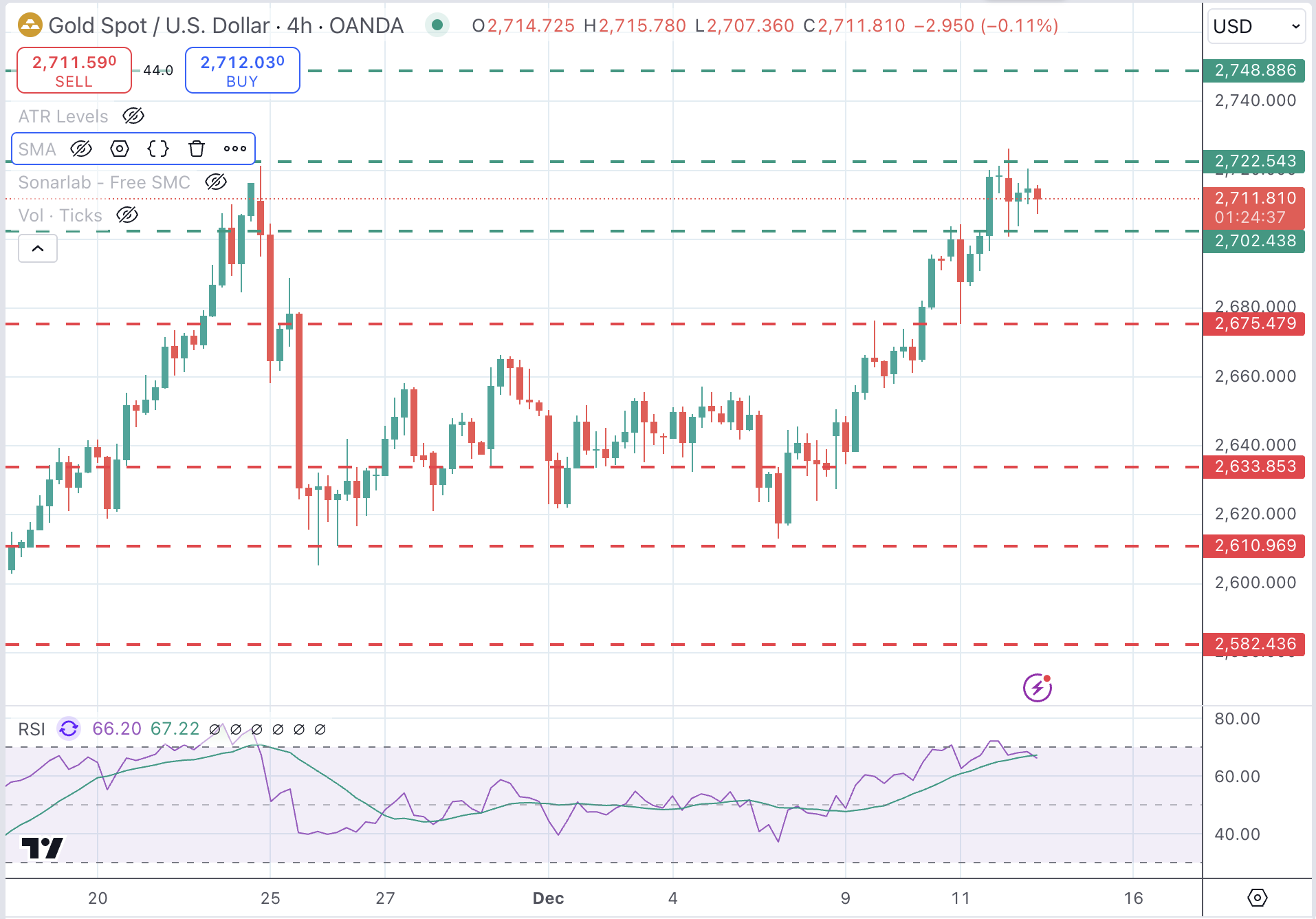- The Gold rally halts right below a one-month high at $2,720, but downside attempts are limited.
- Higher Treasury yields are acting as support for the US Dollar and weighing on the recent Gold rally.
- XAU/USD broader technical picture remains positive, with price action printing higher highs and higher lows.
Gold (XAU/USD) is hesitating below a one-month high at $2,720 on Thursday’s European session following a sharp rally over the last three days. The rebound on US Treasury yields, with the benchmark 10-year yield more than 15 pips above last week’s lows, is weighing on the precious metal’s rally.
However, downside attempts remain limited, with investors nearly fully pricing a 25 basis points (bps) interest-rate cut by the Federal Reserve (Fed) next week. The hot US Consumer Price Index (CPI) report did not scratch investors’ hopes of further monetary easing, although the outlook of a shallower easing cycle in 2025 underpins the US Dollar (USD).
Daily digest market movers: Gold rally stalls with the Dollar steady near two-week highs
- US consumer prices grew at their fastest pace in seven months, 0.3% up in November compared with the previous month and 2.6% year-on-year, from 0.2% and 2.6%, respectively. The core CPI remained steady at 0.3% monthly and 3.3% from November last year.
- Market expectations of a 25 bps Fed rate cut on December 18 increased to 98% from 85% before the CPI release and around 75% last week, as shown by the CME Group’s Fed Watch Tool.
- Futures markets are increasingly pricing the chance of two additional rate cuts in 2025, instead of three as previously thought.
- Strong US macroeconomic data and expectations of higher inflation stemming from Donald Trump’s policies are forcing investors to scale back Fed easing prospects, and pushing US yields higher.
- The yield of the benchmark 1-year Treasury note has reached 4.30% from 4.12% lows last week after having rallied for four consecutive days. This provides important support to the Greenback.
- The Swiss National Bank (SNB) cut interest rates by 50 basis points against market expectations of a 25 bps cut. The European Central Bank (ECB) is next with the market consensus anticipating a quarter-point interest-rate cut. Another jumbo cut would rattle markets and send the US Dollar higher.
Technical analysis: XAU/USD consolidates with $2,720 resistance in focus
Gold’s rally has lost some steam, with US Treasury yields bouncing up and the US Dollar appreciating on the back of strong US inflation data. However, the broader trend remains positive, with bearish attempts contained above $2,700.
On the upside, the November 24 high at $2,720 emerges as the first resistance. The next upside target is the November 4, 5 and 6 highs at around $2,750.
On the downside, previous resistance at around $2,700 (December 10 high) is acting now as support ahead of the $2,675 intra-day level and the December 9 low at $2,630.
XAU/USD 4-Hour Chart

Gold FAQs
Gold has played a key role in human’s history as it has been widely used as a store of value and medium of exchange. Currently, apart from its shine and usage for jewelry, the precious metal is widely seen as a safe-haven asset, meaning that it is considered a good investment during turbulent times. Gold is also widely seen as a hedge against inflation and against depreciating currencies as it doesn’t rely on any specific issuer or government.
Central banks are the biggest Gold holders. In their aim to support their currencies in turbulent times, central banks tend to diversify their reserves and buy Gold to improve the perceived strength of the economy and the currency. High Gold reserves can be a source of trust for a country’s solvency. Central banks added 1,136 tonnes of Gold worth around $70 billion to their reserves in 2022, according to data from the World Gold Council. This is the highest yearly purchase since records began. Central banks from emerging economies such as China, India and Turkey are quickly increasing their Gold reserves.
Gold has an inverse correlation with the US Dollar and US Treasuries, which are both major reserve and safe-haven assets. When the Dollar depreciates, Gold tends to rise, enabling investors and central banks to diversify their assets in turbulent times. Gold is also inversely correlated with risk assets. A rally in the stock market tends to weaken Gold price, while sell-offs in riskier markets tend to favor the precious metal.
The price can move due to a wide range of factors. Geopolitical instability or fears of a deep recession can quickly make Gold price escalate due to its safe-haven status. As a yield-less asset, Gold tends to rise with lower interest rates, while higher cost of money usually weighs down on the yellow metal. Still, most moves depend on how the US Dollar (USD) behaves as the asset is priced in dollars (XAU/USD). A strong Dollar tends to keep the price of Gold controlled, whereas a weaker Dollar is likely to push Gold prices up.
























